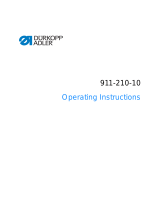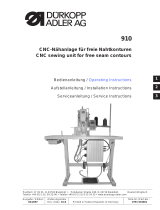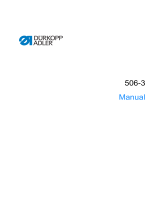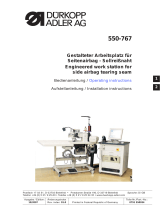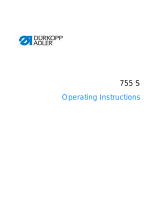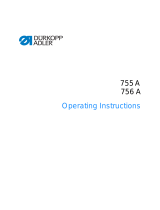Page is loading ...

906
Operating Instructions
DA_906-01_deen_08-2014.qxd:DA-6-pages.qxd 13.08.2014 10:39 Uhr Seite 3

All rights reserved.
Property of Dürkopp Adler AG and protected by copyright. Any reuse of these contents,
including extracts, is prohibited without the prior written approval of Dürkopp Adler AG.
Copyright © Dürkopp Adler AG 2016
IMPORTANT
READ CAREFULLY BEFORE USE
KEEP FOR FUTURE REFERENCE

Table of Contents
Operating Instructions 906 - 02.0 - 11/2016 1
1 About these instructions ...........................................................5
1.1 For whom are these instructions intended?..................................5
1.2 Representation conventions – symbols and characters...............5
1.3 Other documents..........................................................................7
1.4 Liability..........................................................................................7
2 Safety...........................................................................................9
2.1 Basic safety instructions...............................................................9
2.2 Signal words and symbols used in warnings..............................10
3 Machine description.................................................................13
3.1 Components of the machine.......................................................13
3.2 Proper use..................................................................................14
3.3 Declaration of Conformity...........................................................14
4 Operation...................................................................................15
4.1 Switching on and off the machine...............................................15
4.2 Switching on and off threading mode.........................................16
4.3 Switching on Quick-stop.............................................................17
4.4 Sewing on pre-bound pockets....................................................19
4.5 Swiveling the machine head.......................................................21
4.5.1 Swiveling up the machine head..................................................22
4.5.2 Swiveling down the machine head.............................................23
4.6 Inserting/changing the needle ....................................................24
4.7 Threading the needle thread ......................................................25
4.8 Setting the thread regulator........................................................27
4.9 Winding the hook thread.............................................................28
4.10 Changing the bobbin ..................................................................29
4.11 Thread tension............................................................................31
4.11.1 Setting the needle thread tension...............................................31
4.11.2 Setting the hook thread tension..................................................32
4.12 Changing the configuration set...................................................33
4.12.1 Activating the clamp change mode.............................................34
4.12.2 Changing the outer frame and inner slider .................................34
4.12.3 Changing the transfer plate ........................................................36
4.12.4 Ending clamp change mode.......................................................37
5 Programming ............................................................................39
5.1 Structure of the software ............................................................39
5.2 Overview of the menu structure..................................................40
5.3 Starting the software...................................................................41
5.4 Basic functions for using the software........................................44
5.4.1 Enter master password...............................................................44
5.4.2 Closing windows.........................................................................44
5.4.3 Display principles........................................................................45
5.4.4 Scrolling the display....................................................................45
5.4.5 Selecting options from a list........................................................46
5.4.6 Using file filters...........................................................................47
5.4.7 Entering text ...............................................................................48
5.4.8 Entering parameter values .........................................................49
5.4.9 Switching on and off the full-screen display ...............................50
5.4.10 Switching on and off zoom .........................................................50

Table of Contents
2 Operating Instructions 906 - 02.0 - 11/2016
5.5 Opening a seam program or sequence for sewing.....................50
5.6 Briefly sewing with modified values............................................51
5.6.1 Sewing with a modified thread tension.......................................51
5.6.2 Sewing with a modified speed....................................................52
5.7 Fixing a thread breakage............................................................53
5.8 Continuing a seam in Repair mode after an error.......................54
5.9 Resetting the counter .................................................................54
5.10 Creating a new seam program...................................................55
5.11 Setting Mode X in Load and Deposit mode................................58
5.12 Performing a contour test...........................................................60
5.13 Creating a sequence ..................................................................61
5.14 Editing an existing sequence......................................................62
5.15 Saving a seam program/sequence under a different name........63
5.16 Copying a seam program or sequence ......................................63
5.17 Deleting a seam program or sequence ......................................65
5.18 Editing an existing seam program ..............................................65
5.19 Adjusting a contour.....................................................................66
5.20 Changing parameters.................................................................69
5.21 Editing machine parameters.......................................................74
5.22 Checking and changing the technical settings ...........................78
5.22.1 Adjusting the basic functions......................................................79
5.22.2 Displaying system information....................................................81
5.22.3 Testing MultiTest machine functions..........................................82
5.22.4 Initializing the control, performing updates.................................87
6 Creating programs with DA-CAD 5000...................................91
7 Maintenance..............................................................................95
7.1 Cleaning .....................................................................................96
7.2 Lubricating..................................................................................97
7.3 Servicing the pneumatic system.................................................99
7.3.1 Setting the operating pressure ...................................................99
7.3.2 Draining the water condensation..............................................100
7.3.3 Cleaning the filter element........................................................101
7.4 Parts list....................................................................................102
8 Setup........................................................................................103
8.1 Checking the scope of delivery.................................................103
8.2 Removing the transport locks...................................................104
8.3 Setting up the machine.............................................................105
8.3.1 Aligning the machine ................................................................105
8.3.2 Assembling the automatic stacker............................................106
8.3.3 Assembling the reel stand ........................................................107
8.3.4 Pedal setup...............................................................................107
8.4 Electrical connection.................................................................108
8.5 Pneumatic connection..............................................................109
8.6 Oil lubrication............................................................................110
8.7 Performing a test run................................................................112
8.8 Transporting the machine.........................................................114
9 Decommissioning...................................................................115
9.1 Decommissioning the machine.................................................115
9.2 Dismantling the automatic stacker............................................116

Table of Contents
Operating Instructions 906 - 02.0 - 11/2016 3
10 Packaging, transportation .....................................................117
10.1 Assembling the transport locks.................................................117
10.2 Rotating the stand feet upwards...............................................117
10.3 Packing the machine................................................................118
10.4 Transporting the machine.........................................................119
11 Disposal...................................................................................121
12 Troubleshooting .....................................................................123
12.1 Customer Service.....................................................................123
12.2 Messages of the software.........................................................123
12.2.1 Information messages..............................................................124
12.2.2 Error messages........................................................................124
12.2.3 Errors in sewing process ..........................................................128
13 Technical data.........................................................................131
14 Appendix .................................................................................135

Table of Contents
4 Operating Instructions 906 - 02.0 - 11/2016

About these instructions
Operating Instructions 906 - 02.0 - 11/2016 5
1 About these instructions
These instructions have been prepared with utmost care. They contain in-
formation and notes intended to ensure long-term and reliable operation.
Should you notice any discrepancies or if you have improvement requests,
then we would be glad to receive your feedback through Customer
Service ( p. 123).
Consider the instructions part of the product and store them in a place
where they are readily available.
1.1 For whom are these instructions intended?
These instructions are intended for:
• Operators:
This group is familiar with the machine and has access to the
instructions. Specifically, chapter Operation ( p. 15) is important
for the operators.
• Specialists:
This group has the appropriate technical training for performing
maintenance or repairing malfunctions. Specifically, the chapter
Setup ( p. 103) is important for specialists.
Service Instructions are supplied separately.
With regard to minimum qualification and other requirements to be met by
personnel, please also follow the chapter Safety ( p. 9).
1.2 Representation conventions – symbols and characters
Various information in these instructions is represented or highlighted by the
following characters in order to facilitate easy and quick understanding:
Proper setting
Specifies proper setting.
Disturbances
Specifies the disturbances that can occur from an incorrect setting.
Cover
Specifies which covers must be disassembled in order to access the com-
ponents to be set.

About these instructions
6 Operating Instructions 906 - 02.0 - 11/2016
Steps to be performed when operating the machine (sewing and
equipping)
Steps to be performed for service, maintenance, and installation
Steps to be performed via the software control panel
The individual steps are numbered:
First step
Second step
The steps must always be followed in the specified order.
Lists are marked by bullet points.
Result of performing an operation
Change to the machine or on the display/control panel.
Important
Special attention must be paid to this point when performing a step.
Information
Additional information, e.g. on alternative operating options.
Order
Specifies the work to be performed before or after a setting.
References
Reference to another section in these instructions.
Safety Important warnings for the user of the machine are specifically marked.
Since safety is of particular importance, hazard symbols, levels of danger
and their signal words are described separately in the chapter Safety
( p. 9).
Location
information
If no other clear location information is used in a figure, indications of right
or left are always from the user's point of view.
1.
2.
…
•

About these instructions
Operating Instructions 906 - 02.0 - 11/2016 7
1.3 Other documents
The machine includes components from other manufacturers. Each man-
ufacturer has performed a hazard assessment for these purchased parts
and confirmed their design compliance with applicable European and na-
tional regulations. The proper use of the built-in components is described
in the corresponding manufacturer's instructions.
1.4 Liability
All information and notes in these instructions have been compiled in
accordance with the latest technology and the applicable standards and
regulations.
Dürkopp Adler cannot be held liable for any damage resulting from:
• Breakage and damage during transport
• Failure to observe these instructions
• Improper use
• Unauthorized modifications to the machine
• Use of untrained personnel
• Use of unapproved parts
Transport
Dürkopp Adler cannot be held liable for breakage and transport damages.
Inspect the delivery immediately upon receiving it. Report any damage
to the last transport manager. This also applies if the packaging is not
damaged.
Leave machines, equipment and packaging material in the condition in
which they were found when the damage was discovered. This will ensure
any claims against the transport company.
Report all other complaints to Dürkopp Adler immediately after receiving
the product.

About these instructions
8 Operating Instructions 906 - 02.0 - 11/2016

Safety
Operating Instructions 906 - 02.0 - 11/2016 9
2 Safety
This chapter contains basic information for your safety. Read the instruc-
tions carefully before setting up or operating the machine. Make sure to
follow the information included in the safety instructions. Failure to do so
can result in serious injury and property damage.
2.1 Basic safety instructions
The machine may only be used as described in these instructions.
These instructions must be available at the machine's location at all times.
Work on live components and equipment is prohibited. Exceptions are
defined in the DIN VDE 0105.
For the following work, switch off the machine at the main switch or
disconnect the power plug:
• Replacing the needle or other sewing tools
• Leaving the workstation
• Performing maintenance work and repairs
• Threading
Missing or faulty parts could impair safety and damage the machine.
Only use original parts from the manufacturer.
Transport Use a lifting carriage or forklift to transport the machine. Raise the machine
max. 20 mm and secure it to prevent it from slipping off.
Setup The connecting cable must have a power plug approved in the relevant
country. The power plug may only be assembled to the power cable by
qualified specialists.
Obligations
of the operator
Follow the country-specific safety and accident prevention regulations and
the legal regulations concerning industrial safety and the protection of the
environment.
All the warnings and safety signs on the machine must always be in legible
condition. Do not remove!
Missing or damaged warnings and safety signs must be replaced
immediately.
Requirements
to be met by
the personnel
Only qualified specialists may:
• set up the machine
• perform maintenance work and repairs
• perform work on electrical equipment
Only authorized persons may work on the machine and must first have
understood these instructions.

Safety
10 Operating Instructions 906 - 02.0 - 11/2016
Operation Check the machine during operating for any externally visible damage.
Stop working if you notice any changes to the machine. Report any chang-
es to your supervisor. Do not use a damaged machine any further.
Safety
equipment
Safety equipment should not be removed or deactivated. If it is essential
to remove or deactivate safety equipment for a repair operation, it must be
assembled and put back into operation immediately afterward.
2.2 Signal words and symbols used in warnings
Warnings in the text are distinguished by color bars. The color scheme is
based on the severity of the danger. Signal words indicate the severity of
the danger.
Signal words Signal words and the hazard they describe:
Symbols The following symbols indicate the type of danger to personnel:
Signal word Meaning
DANGER (with hazard symbol)
If ignored, fatal or serious injury will result
WARNING (with hazard symbol)
If ignored, fatal or serious injury can result
CAUTION (with hazard symbol)
If ignored, moderate or minor injury can result
CAUTION (with hazard symbol)
If ignored, environmental damage can result
NOTICE (without hazard symbol)
If ignored, property damage can result
Symbol Type of danger
General
Electric shock
Puncture

Safety
Operating Instructions 906 - 02.0 - 11/2016 11
Examples Examples of the layout of warnings in the text:
This is what a warning looks like for a hazard that will result in serious
injury or even death if ignored.
This is what a warning looks like for a hazard that could result in seri-
ous or even fatal injury if ignored.
This is what a warning looks like for a hazard that could result in
moderate or minor injury if the warning is ignored.
Crushing
Environmental damage
Symbol Type of danger
DANGER
Type and source of danger!
Consequences of non-compliance.
Measures for avoiding the danger.
WARNING
Type and source of danger!
Consequences of non-compliance.
Measures for avoiding the danger.
CAUTION
Type and source of danger!
Consequences of non-compliance.
Measures for avoiding the danger.

Safety
12 Operating Instructions 906 - 02.0 - 11/2016
This is what a warning looks like for a hazard that could result in envi-
ronmental damage if ignored.
This is what a warning looks like for a hazard that could result in
property damage if ignored.
CAUTION
Type and source of danger!
Consequences of non-compliance.
Measures for avoiding the danger.
NOTICE
Type and source of danger!
Consequences of non-compliance.
Measures for avoiding the danger.

Machine description
Operating Instructions 906 - 02.0 - 11/2016 13
3 Machine description
3.1 Components of the machine
Fig. 1: Components of the machine (1)
Fig. 2: Components of the machine (2)
(1) - Quick-stop
(2) - Reel stand
(3) - Machine head
(4) - Tabletop
(5) - Tray
(6) - Protective bar
(7) - Pedal
(8) - Stand
(9) - Sewing material surface
(10) - Start buttons
(11) - Automatic material feeder
(12) - Control operating terminal
⑫
⑪
⑩
⑧
⑦
①②
⑨
③
④
⑤
⑥
(1) - Compressed air gun
(2) - Compressed air maintenance unit
(3) - Main switch
②
①
③

Machine description
14 Operating Instructions 906 - 02.0 - 11/2016
3.2 Proper use
The machine may only be used with sewing material that satisfies the
requirements of the specific application at hand.
The machine is intended only for use with dry sewing material. The sewing
material must not contain any hard objects.
The needle thicknesses permissible for the machine are listed in the
Technical data ( p. 131) chapter.
The seam must be completed with a thread that satisfies the requirements
of the specific application at hand.
The machine is intended for industrial use.
The machine may only be set up and operated in dry conditions on well-
maintained premises. If the machine is operated on premises that are not
dry and well-maintained, then further measures may be required which
must be compatible with DIN EN 60204-31.
Only authorized persons may work on the machine.
Dürkopp Adler cannot be held liable for damages resulting from improper
use.
3.3 Declaration of Conformity
The machine complies with European regulations ensuring health, safety,
and environmental protection as specified in the declaration of conformity
or in the declaration of incorporation.
WARNING
Risk of injury from live, moving and cutting
parts as well as from sharp parts!
Improper use can result in electric shock, crushing,
cutting and punctures.
Follow all instructions provided.
NOTICE
Non-observance will lead to property damage!
Improper use can result in material damage at the machine.
Follow all instructions provided.

Operation
Operating Instructions 906 - 02.0 - 11/2016 15
4 Operation
The operating sequence consists of several different steps. Fault-free op-
eration is necessary in order to achieve a good sewing result.
4.1 Switching on and off the machine
Abb. 3: Switching on and off the machine
Switching on the machine
To switch on the machine:
1. Turn the main switch (1) to the right into the I position.
The machine performs a reference run.
After referencing, the startup screen is displayed on the operating ter-
minal for a few seconds.
Information
On the start screen, you can set the language for the user interface in the
Language menu or open the Service menu ( p. 41).
(1) - Main switch
①

Operation
16 Operating Instructions 906 - 02.0 - 11/2016
Switching off the machine
To switch off the machine:
1. Turn the main switch (1) to the left into the 0 position.
All drives and the control are disconnected from the mains grid.
4.2 Switching on and off threading mode
Abb. 4: Switching on and off threading mode
WARNING
Risk of injury from sharp and moving parts!
Puncture or crushing possible.
The machine must be switched off in advance
before all preparation, maintenance and cleaning
work on the machine.
When threading mode is active, do not reach into
the hook area until this is lit up.
(1) - Drive carriage
(2) - Hook cover
(3) - Threading mode push button
③
②
①

Operation
Operating Instructions 906 - 02.0 - 11/2016 17
Switching on threading mode
1. Press in push button (3).
Important
The button must latch into place.
The machine is in threading mode.
The drive carriage (1) is moved to the left position.
The lamp in the button lights up.
The area around the hook cover (2) is lit up.
Switching off threading mode
1. Press in the push button (3).
Important
The push button must latch out of place.
4.3 Switching on Quick-stop
The Quick-stop switch (1) can be used to immediately stop all working
steps on the machine, e.g. after an operating error.
WARNING
Risk of injury from moving parts!
Crushing possible.
After a Quick-stop, power is still present in the
machine, and the clamps can move.
You must always switch the machine off at the main
switch before performing any maintenance or
cleaning work.

Operation
18 Operating Instructions 906 - 02.0 - 11/2016
Stopping working steps via Quick-stop
Abb. 5: Switching on Quick-stop (1)
1. Press the Quick-stop switch (1).
All working steps on the machine are immediately stopped.
Switching off the power to the machine
Abb. 6: Switching on Quick-stop (2)
1. Turn the main switch (2) to the left into the 0 position.
All drives and the control are immediately disconnected from the
mains grid.
(1) - Quick Stop switch
①
(2) - Main switch
②
/

